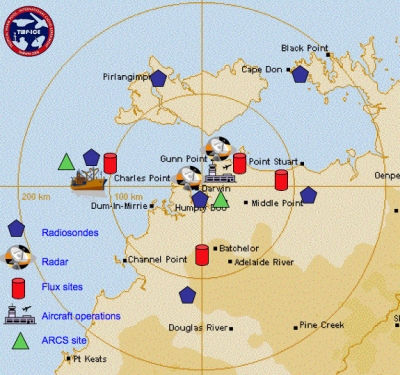Overview
One of the most complete data sets of tropical cirrus and convection observations ever collected resulted from the Tropical Warm Pool International Cloud Experiment (TWPICE) in the area around Darwin, Australia, in early 2006. The aim of the experiment was to examine convective cloud systems from their initial stages through to the decaying and thin high level cirrus and measure their impact on the environment. The experiment design included an unprecedented array of soundings and other information to support cloud resolving and other modeling studies as well as a large range of in-situ and remotely sensed observation platforms. This large multi-agency experiment involved substantial contributions from the following entities:
- U.S. Department of Energy, ARM Program;
- U.S. National Aeronautics and Space Administration (NASA);
- Australian Bureau of Meteorology (BoM); and
- Commonwealth Scientific and Industrial Research Organization (CSIRO)
A number of universities and a group sponsored by the European Union also contributed instrumentation to the experiment.
A key component of the field campaign was a fleet of aircraft including the Dornier, Dimona, Egrett, Twin Otter, and Proteus. Together, these aircraft collected measurements of cloud properties and the meteorological environment from the planetary boundary layer up to 15 km high. An extensive ground network of cloud sensing radar, lidar and passive instruments was located on a ship and several ground sites throughout the experimental domain.
Keep up with the Atmospheric Observer
Updates on ARM news, events, and opportunities delivered to your inbox
ARM User Profile
ARM welcomes users from all institutions and nations. A free ARM user account is needed to access ARM data.



















